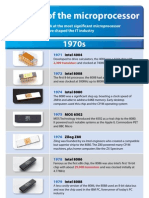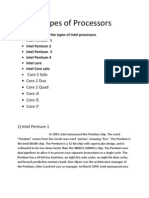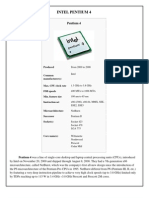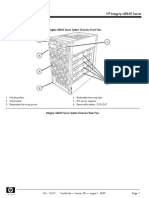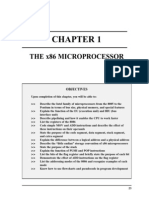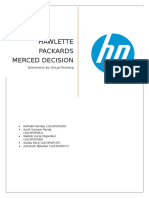Linea Del Tiempo
Linea Del Tiempo
Uploaded by
Phabian GonzalezCopyright:
Available Formats
Linea Del Tiempo
Linea Del Tiempo
Uploaded by
Phabian GonzalezCopyright
Available Formats
Share this document
Did you find this document useful?
Is this content inappropriate?
Copyright:
Available Formats
Linea Del Tiempo
Linea Del Tiempo
Uploaded by
Phabian GonzalezCopyright:
Available Formats
HISTORICAL
INTEL
TIMELINE
by Myles White
4004 processor
Intel's first microprocessor. Developed for the Busicom calculator, it is credited with paving the way for embedding "intelligence" in inanimate objects. It became the first microprocessor to be sold commercially when Busicom decided it didn't want the device. It featured 2,300 transistors, 4-bit processing, 108KHz, 60,000 instructions per second (0.06 MIPs), and 10-micron technology.
Became the brains of the first PC: the MITS Altair, a $395 kit. Within months, it sold tens of thousands, creating the first PC back orders in history. The 8080 had a 2MHz internal speed, addressed 64KB of memory, and used a 6-micron fabrication process with 6,000 transistors. Produced 0.64 MIPs.
8080 processor
The 286 processor was still a 16-bit part, but it improved on the architecture, adding protected mode and keeping backward compatibility with software produced for the earlier 8088/86 CPUs. At launch, it ran at 20MHz and addressed up to 16MB of electronic memory (up to 1GB of "virtual memory" adding hard drive space).
1971
8008 processor
1972
1974
8086/8088 processor
80286 processor
1982
Twice as powerful as the 4004, the 8008 ran at 200KHz, featured 8-bit processing, and accessed 16KB of memory (instead of 4KB). It still used 10-micron technology but featured 3,500 transistors and produced 0.06 MIPs.
The 8086 was the first 16-bit 1978 processor, but it came too early (and was considered too expensive), so an 8-bit version of the chip was produced for the first IBM PC and early XTs. The 808x processors reached 10MHz and 29,000 transistors, produced upwards of 0.8 MIPs, and addressed up to 1MB of memory.
80386 processor
Until now, Intel has made one stream of processor (except for the Pentium Pro), while salesfolk bill the latest, fastest processor as "meant to be a server processor." With the release of the first Xeon, however, Intel began making products specifically for server use. Pentium II Xeon CPUs can also be scaled in 4- and 8-way applications (eight processors per computer, for instance). processor
Pentium II Xeon
1998
Built on the Pentium Pro core and including the MMX instruction set, the PII introduces the SECC and Slot 1. PII debuts at 233MHz on a 66MHz fsb (frontside bus) and finally retires as a 0.25-micron CPU, running at 450MHz on a 100MHz fsb.
The 486 came in several flavors: the DX series (with processor on-die math coprocessor), which ran at up to 50MHz; 1989 the SX series (with the math coprocessor removed to save cost); the SX2 series (with doubled internal clock speed but still no math coprocessor); and the DX2/DX4 series (with processors that ran at a faster internal speed than the main system bus on which they were installed).
80486
The AT-386 maintained backward compatibility with earlier software, enhanced protected mode, and introduced 386 1985 Enhanced Mode for Windows users. Its 32-bit flat memory addressing scheme was a major step in CPU development. It had 275,000 transistors, produced 6.0 MIPs, and addressed up to 4GB of memory with an internal clock speed of 33MHz.
Pentium II processor
1997
Pentium processor
Pentium Pro processor
Billed as a "corporate 1995 server" product, the Pentium Pro was designed primarily to handle 32-bit software and didn't run 16-bit products as well as the Pentium and Pentium MMX did. While the Pentium Pro was ultimately orphaned by Intel, it still comprised the core architecture of the company's next three generations of PC processors.
Billed as the processor that was "just good enough" for processor the average consumer to use 1999 for light word processing and to get on the Internet. Though the name has stayed the same, the Celeron line has evolved, always a few steps behind the leading architecture and speed and/or the latest instruction set. It's still regarded by Intel as an entrylevel CPU and is not recommended for corporate use.
Celeron
Despite appearing three generations later, the Pentium 4 is still an 80686 at heart, but there have been a lot of add-ons. The P4 is up to 42 million transistors on 0.18-micron lines (and soon down to 90 nanometers). The current P4 runs at 3.2GHz internally on an 800MHz main system bus. Intel admitted when the processor was released that it was not optimized for business applications but was instead primarily for Internet content creation.
The Pentium would have been the 80586 processor if Intel had kept its numbering scheme, but 1993 copyright issues forced a change in marketing strategy. Initially 3.3 million transistors in a 60MHz or 66MHz version, the Pentium eventually ran at internal speeds of 200MHz. The original Pentium was retired in 1997 with the release of the Pentium MMX. The Pentium MMX was short-lived, debuting at 160MHz and retiring at 233MHz in 1998.
Pentium 4 processor
2000
Although the original Itanium is still in stock, the company would much rather you chose the newer and more sophisticated Itanium 2, the second-generation 64-bit processor. Unlike the Xeon, with its miniscule applications with 32 processors, Intel reports at least one company (British Petroleum) using 1,000 Itaniums for its seismic mapping.
Intel processor 2 Itanium
2002
Still based on the Pentium Pro 1999 core, the PIII added 70 new Streaming SIMD multimedia instructions optimized for Internet content creation. At its debut, it used 9.5 million transistors on a 0.25-micron fab process with an internal speed of 450MHz on a 100MHz fsb. The final PIII reached 1.2GHz on a 133MHz fsb. The Xeon version also had Streaming SIMD instructions but much larger cache and multiprocessor capability.
Pentium III/Pentium III Xeon processor
Intel Xeonprocessor Xeon MP and
2001
Intelprocessor Itanium
2001
Current 2003 Xeons are Pentium 4-based CPUs but with much higher cache memory allotments. There are also two Xeon models: the Xeon and the Xeon MP. Although the Xeon MP is theoretically capable of 128-way processing, the largest anyone at Intel knows about uses 32 Xeon MP CPUs.
Itanium and its successor, the Itanium 2, are for applications that use huge amounts of memory (up to 1PB [petabyte; equal to 1 million GB]). The Itanium would have been the 80786, except that being built from the ground up, it bears little relationship to the company's previous x86 products. Itanium has an entirely new architecture based on Intel's EPIC design technology.
Copyright by Sandhills Publishing Company 2003. All rights reserved. Reproduction of these materials without written permission is strictly prohibited.
You might also like
- Xbox Architecture: Architecture of Consoles: A Practical Analysis, #13From EverandXbox Architecture: Architecture of Consoles: A Practical Analysis, #13No ratings yet
- PlayStation Architecture: Architecture of Consoles: A Practical Analysis, #6From EverandPlayStation Architecture: Architecture of Consoles: A Practical Analysis, #6No ratings yet
- History Intel ProcessorsDocument5 pagesHistory Intel Processorsjohncel89100% (1)
- ProcessorsDocument2 pagesProcessorsShashi Prabha SaraswatNo ratings yet
- Processors:: INTEL 8086Document10 pagesProcessors:: INTEL 8086jazibNo ratings yet
- Evolution of Microprocessor 2Document4 pagesEvolution of Microprocessor 2yayavaramNo ratings yet
- TO Micro Computer AND MicroprocessorDocument75 pagesTO Micro Computer AND MicroprocessorPiyush PandeyNo ratings yet
- MicroprocessorDocument108 pagesMicroprocessorShailendra KumarNo ratings yet
- Introduction To Microprocessor 8085Document88 pagesIntroduction To Microprocessor 8085Dakwah IslamNo ratings yet
- Unit-III Telugu AckDocument46 pagesUnit-III Telugu AckNarasimha Murthy YayavaramNo ratings yet
- Intel I3 ProcessorDocument8 pagesIntel I3 ProcessorArpit Upadhyay100% (1)
- Evolution of ProcessorDocument6 pagesEvolution of ProcessorAshley NohayNo ratings yet
- Microprocessor Assignment: Priyank Mandal 285/C0/07Document11 pagesMicroprocessor Assignment: Priyank Mandal 285/C0/07Priyank MandalNo ratings yet
- 4thsem Microprocessor Notes PDFDocument148 pages4thsem Microprocessor Notes PDFVishal SharmaNo ratings yet
- Intro To MicroDocument9 pagesIntro To MicroAnonymous Jy6ASdQ45JNo ratings yet
- Microprocessor Timeline INQDocument1 pageMicroprocessor Timeline INQEko Teguh TriwisudaNo ratings yet
- MicroprocessorDocument12 pagesMicroprocessorMishalNo ratings yet
- Evolution of Intel ProcessorsDocument4 pagesEvolution of Intel Processors이고양No ratings yet
- Evolution of MPDocument3 pagesEvolution of MPcoolvadivelNo ratings yet
- Hardware, Software and Data Communications CPU: Control UnitDocument30 pagesHardware, Software and Data Communications CPU: Control Unithakoragilbert1No ratings yet
- Microprocesso (Final)Document9 pagesMicroprocesso (Final)Jhunnel MaganesNo ratings yet
- ScribedDocument6 pagesScribedHemant MehtaNo ratings yet
- Architecture and Programming of x86 Processors: Microprocessor Techniques and Embedded SystemsDocument24 pagesArchitecture and Programming of x86 Processors: Microprocessor Techniques and Embedded SystemslimbusNo ratings yet
- Microprocessor TimelineDocument6 pagesMicroprocessor Timelinetopogigio240No ratings yet
- 272CO07Document9 pages272CO07Nishesh AggarwalNo ratings yet
- My Architecture Term PaperDocument15 pagesMy Architecture Term PaperJaganmoy DewasyNo ratings yet
- Mohan Ty Intel Survey 2000Document14 pagesMohan Ty Intel Survey 2000shahbunafNo ratings yet
- Introduction To Microprocessors and ComputersDocument24 pagesIntroduction To Microprocessors and ComputershrrameshhrNo ratings yet
- MPMC Mod-1Document32 pagesMPMC Mod-1Syeda AfreenNo ratings yet
- Processor HistoryDocument4 pagesProcessor Historysheham ihjamNo ratings yet
- Central Processing UnitDocument14 pagesCentral Processing UnitOladimeji YusufNo ratings yet
- Pentium EvolutionsDocument1 pagePentium Evolutionszelalem2022No ratings yet
- Intel Microprocessor 8086,386, 486 & Pentium ProcessorDocument16 pagesIntel Microprocessor 8086,386, 486 & Pentium ProcessorUdit JainNo ratings yet
- Module 4 - CODocument10 pagesModule 4 - COAnnabelleNo ratings yet
- Intel P5 (Microarchitecture) : Navigation SearchDocument13 pagesIntel P5 (Microarchitecture) : Navigation SearchLudwig McwillsNo ratings yet
- Tukwila Itanium ProcessorDocument3 pagesTukwila Itanium Processorchandran3519No ratings yet
- Timeline: A Brief History of The x86 Microprocessor: by Gary AnthesDocument4 pagesTimeline: A Brief History of The x86 Microprocessor: by Gary AnthesGeorgiana DanilaNo ratings yet
- Case StudyDocument73 pagesCase StudyMisha WaseemNo ratings yet
- Whcamacho - It150-8 - Ass 2.1Document2 pagesWhcamacho - It150-8 - Ass 2.1MICKAELA YEOGE BASCONo ratings yet
- Practical No. - 1Document55 pagesPractical No. - 1Rashi SharmaNo ratings yet
- Experiment-1: Aim of The ExperimentDocument27 pagesExperiment-1: Aim of The ExperimentsoniaNo ratings yet
- Advanced Computer Architecture (ACA) /lecture: LV64-446, Module MV5.1Document101 pagesAdvanced Computer Architecture (ACA) /lecture: LV64-446, Module MV5.1fahadned5717No ratings yet
- Processor Families: by Prabhanshu Tripathi Ankit GuptaDocument25 pagesProcessor Families: by Prabhanshu Tripathi Ankit GuptaAnupam Kumar Sinha100% (1)
- Chapter1 - The 80x86 MicroprocessorsDocument77 pagesChapter1 - The 80x86 MicroprocessorsAliaa TarekNo ratings yet
- Processor HistoryDocument5 pagesProcessor HistoryAman KumarNo ratings yet
- Central Processing Unit: E5164 Diagnosis Senggaraan Sistem KomputerDocument38 pagesCentral Processing Unit: E5164 Diagnosis Senggaraan Sistem Komputerfred5181No ratings yet
- Processor Families: by Prabhanshu Tripathi Ankit GuptaDocument25 pagesProcessor Families: by Prabhanshu Tripathi Ankit GuptaAnasNo ratings yet
- Microp AssigDocument4 pagesMicrop AssigHamsewaany ImmanuelNo ratings yet
- Lecture 03 (CF)Document27 pagesLecture 03 (CF)sazuli39No ratings yet
- Types of ProcessorsDocument7 pagesTypes of ProcessorsTayyab1467% (3)
- Pentium 4Document11 pagesPentium 4Moni KrishNo ratings yet
- Basic Characteristics of Intel Pentium Pro ProcessorDocument3 pagesBasic Characteristics of Intel Pentium Pro ProcessorShefali PatelNo ratings yet
- Microprocessor Intel x86 Evolution and Main FeaturesDocument3 pagesMicroprocessor Intel x86 Evolution and Main Featuresezekiel nyamuNo ratings yet
- Chapter ThreeDocument4 pagesChapter Threeibrahin mahamedNo ratings yet
- IntelDocument68 pagesIntelaafaque shaikhNo ratings yet
- Intel Corporation: 1. 1971-4004 MicroprocessorDocument2 pagesIntel Corporation: 1. 1971-4004 MicroprocessorR-MarufNo ratings yet
- Intel ChipsetsDocument3 pagesIntel ChipsetsGhefelyn MedinaNo ratings yet
- 2013bca139 160828094718 PDFDocument40 pages2013bca139 160828094718 PDFkpriya8687No ratings yet
- Quickspecs: HP Integrity Rx8640 Server HP Integrity Rx8640 Server HP Integrity Rx8640 Server HP Integrity Rx8640 ServerDocument35 pagesQuickspecs: HP Integrity Rx8640 Server HP Integrity Rx8640 Server HP Integrity Rx8640 Server HP Integrity Rx8640 Servervkky2k8120No ratings yet
- Tanium Asset 1.5.2 UgDocument53 pagesTanium Asset 1.5.2 UgRaghavNo ratings yet
- The X86 Microprocessor: ObjectivesDocument32 pagesThe X86 Microprocessor: Objectivespapikhu36100% (4)
- HP-UX 11i Support MatrixDocument19 pagesHP-UX 11i Support MatrixSamir ShresthaNo ratings yet
- Winn L. Rosch - Hardware BibleDocument1,151 pagesWinn L. Rosch - Hardware Biblelakatoszoltan92100% (4)
- Amd VS IntelDocument8 pagesAmd VS Intelroberto gonzalezNo ratings yet
- Ansys 8.1 Installation GuideDocument40 pagesAnsys 8.1 Installation GuideaerosanthNo ratings yet
- Using The Intel® License Manager For Flexlm : All Rights Reserved Issued in U.S.A. Document Number: 251879-005Document14 pagesUsing The Intel® License Manager For Flexlm : All Rights Reserved Issued in U.S.A. Document Number: 251879-005gingaNo ratings yet
- Dell Carry-In Service CentersDocument2 pagesDell Carry-In Service CentersRajat GuptaNo ratings yet
- ARIES Technical OverviewDocument68 pagesARIES Technical Overviewdonna5158No ratings yet
- CNSV 1806 Patterson PDFDocument56 pagesCNSV 1806 Patterson PDFRada SihombingNo ratings yet
- Installation Note Hexpress 25 4 UNIX-Acrov5Document28 pagesInstallation Note Hexpress 25 4 UNIX-Acrov5Pandega PutraNo ratings yet
- Container IntegrityDocument97 pagesContainer IntegrityAnoopNo ratings yet
- HP P6000 Enterprise Virtual Array Compatibility ReferenceDocument39 pagesHP P6000 Enterprise Virtual Array Compatibility ReferencePaul BarhamNo ratings yet
- Smartvista On Nonstop: Latest Developments and EnhancementsDocument26 pagesSmartvista On Nonstop: Latest Developments and EnhancementsPradip ShahiNo ratings yet
- Technical Essentials of HP Servers, Rev. 11.41Document72 pagesTechnical Essentials of HP Servers, Rev. 11.41Anonymous CZVjyUzNo ratings yet
- Mastersaf SAP Conector Integration - ENDocument10 pagesMastersaf SAP Conector Integration - ENAdi NagendraNo ratings yet
- Openedge 10 Availability Guide Jan17Document24 pagesOpenedge 10 Availability Guide Jan17Joyce ShiNo ratings yet
- Intel CaseDocument23 pagesIntel CaseLaizaNo ratings yet
- Star CDDocument46 pagesStar CDMuni MuneendranNo ratings yet
- Dell PC Configuration PDFDocument3 pagesDell PC Configuration PDFLouis AndersonNo ratings yet
- PAM For Informatica 9.1.0 HF6Document93 pagesPAM For Informatica 9.1.0 HF6Sudhir JainNo ratings yet
- Operating System ProgramsDocument20 pagesOperating System ProgramsKundan Kumar TiwaryNo ratings yet
- Wa Ae Release Enu Release NotesDocument88 pagesWa Ae Release Enu Release Notesmarlou_mac98No ratings yet
- Intel® Processor Architecture: January 2013Document52 pagesIntel® Processor Architecture: January 2013Aadi KhanNo ratings yet
- Netbackup 6.X Release HistoryDocument32 pagesNetbackup 6.X Release Historysujeel786No ratings yet
- 4thsem Microprocessor Notes PDFDocument148 pages4thsem Microprocessor Notes PDFVishal SharmaNo ratings yet
- HP MercedDocument3 pagesHP MercedSwetaSarojNo ratings yet
- Prada N SAPDocument4 pagesPrada N SAPManjeet KumarNo ratings yet
- HP LaserJet Pro P1108 Printer - Printers - HP Online StoreDocument14 pagesHP LaserJet Pro P1108 Printer - Printers - HP Online Storeds0909@gmailNo ratings yet
















